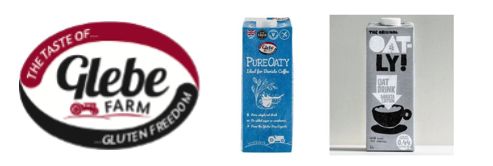Swedish oat milk giant
The market and parties
Oat milk is among the fastest-selling plant-based products.
The claims

Source: Judgement [2021] EWHC 2189 (IPEC)
Concretely, lawyers of
- that the name PureOaty was confusingly similar to
Oatly , - that the blue packaging of PureOaty and image of a teacup was confusingly similar to the packaging and images used by
Oatly , - that the use of PureOaty was intended to benefit from
Oatly's brand, and - that the use of PureOaty was intended "to bring
Oatly's products to mind".
The court's conclusion
What elements are considered when judging trademarks' similarities?
A risk of confusion exists, legally, when the overall impression that remains in the consumers' minds leads to confusion when associating the product with the company producing it. The elements conditioning the overall impression can include e.g. words' look, meaning and sound, as well as images and other conceptual references, e.g. those displayed on a product's packaging. Importantly, common or descriptive words or elements in relation to the relevant goods and services shall remain available for all competitors to use so that they cannot be monopolized by one company. That is why you cannot obtain a trademark for an apple if you are selling apples. This would be to the detriment of all others selling apples.
The comparison of
The only element that the marks had in common were OAT, an element entirely distinctive in relation to the relevant goods and services. The judge ruled that when the common element is descriptive, the significance of conceptual similarity is downgraded. The judge cited e.g. the following from case law: ".where you have something largely descriptive the average consumer will recognize that to be so, expect others to use similar descriptive marks and thus be alert for detail which would differentiate one provider from another." This plainly means that when a company uses something very descriptive in its trademark, such as OAT, the consumer will be more alert to small alterations and the word being used by different providers in various forms, e.g.
In addition, PureOaty disassociated itself from

Source: Judgement [2021] EWHC 2189 (IPEC)
The overall impressions of the trademarks were therefore found to be very different.
aera comments and key takeaways
- As a company, one should be cautious about using very or too descriptive elements in one's brand in relation to the relevant goods and services. More fanciful words or elements in relation to the goods and services provide a stronger protection as clearly seen here.
- By adding additional elements on a package such as logos, flags, emphasizers of quality and illustrations of certain devices, a company can disassociate its trademark further from an otherwise perhaps similar trademark.
- When a large corporation takes on a small local company, there are always several risks to keep in mind strategically. Apart from the legal uncertainty, there is also a public relations risk in the form of a David and Goliath perception in the eyes of the public. There is a risk that the public will sympathize with the smaller company and that negative media attention will hit the larger company as seen in the
Oatly case. It may in worst case turn into a PR crisis as seen when Danish beef restaurant chain "Jensens Břfhus" sued the provincial fish restaurant "Jensens Fiskehus". Despite Jensens Břfhus winning the case at theSupreme Court , a national media outcry arose, 110,000 Danes enrolled in a facebook boycott page, and the company ended up with a deficit of 30 mio DKK. A well-thought-out strategy is therefore crucial. Sometimes the risk is tried reduced by the larger company, either by "letting" the smaller company "live", by picking up the legal bills or by choosing a legal forum where the smaller company will suffer less financial damage. One should therefore always think very strategically when choosing which legal battles to pick, which forum to choose and how to approach the matter wisest. Both from a legal point of view, but also from a business and communication's standpoint.
Should
Read more: Judgement
The content of this article is intended to provide a general guide to the subject matter. Specialist advice should be sought about your specific circumstances.
aera
Gammel Kongevej 60,
18th Floor DK-1850 Frederiksberg C
Frederiksberg
Tel: 23838 838
E-mail: ul@aera-ip.com
URL: aera-ip.com/
© Mondaq Ltd, 2021 - Tel. +44 (0)20 8544 8300 - http://www.mondaq.com, source


